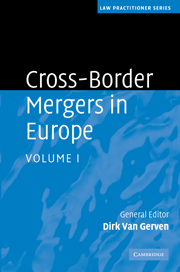Book contents
- Frontmatter
- Contents
- Contributors
- Preface
- Part I EC rules on cross-border mergers
- Part II Application in each Member State National reports for the EU Member States
- 5 Austria
- 6 Belgium
- 7 Bulgaria
- 8 Cyprus
- 9 Czech Republic
- 10 Denmark
- 11 Estonia
- 12 Germany
- 13 Hungary
- 14 The Netherlands
- 15 Poland
- 16 Slovak Republic
- 17 United Kingdom
- Part III Application in the EEA Member States
- Part IV Annexes
- Index
15 - Poland
from Part II - Application in each Member State National reports for the EU Member States
Published online by Cambridge University Press: 03 May 2010
- Frontmatter
- Contents
- Contributors
- Preface
- Part I EC rules on cross-border mergers
- Part II Application in each Member State National reports for the EU Member States
- 5 Austria
- 6 Belgium
- 7 Bulgaria
- 8 Cyprus
- 9 Czech Republic
- 10 Denmark
- 11 Estonia
- 12 Germany
- 13 Hungary
- 14 The Netherlands
- 15 Poland
- 16 Slovak Republic
- 17 United Kingdom
- Part III Application in the EEA Member States
- Part IV Annexes
- Index
Summary
Introduction
1. The Cross-border Merger Directive has been implemented in Poland by the Act of 25 April 2008. The Act amended the Commercial Companies Code by introducing a new section on cross-border mergers. To the extent that the new section does not state otherwise, the provisions on internal merger of Polish companies stipulated by the Commercial Companies Code apply.
Scope of the new rules
2. The new rules on cross-border mergers apply to three company types governed by the Commercial Companies Code. These are: limited liability companies, joint-stock companies and joint-stock limited companies (Art. 491 Commercial Companies Code).
In accordance with the Commercial Companies Code, a merger can take place in the following ways:
(i) one or more companies transfer all their assets and liabilities to another acquiring company, in exchange for the issue of securities or shares representing the capital of that company to their members and, if applicable, a cash payment;
(ii) two or more companies transfer all their assets and liabilities to a company that they form, in exchange for the issue of securities or shares representing the capital of the new company to their members and, if applicable, a cash payment.
In addition, the result of a cross-border merger with the participation of a jointstock limited company may only be an association of capital. The surviving company may never be a partnership.
- Type
- Chapter
- Information
- Cross-Border Mergers in Europe , pp. 257 - 266Publisher: Cambridge University PressPrint publication year: 2010

